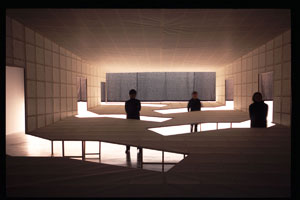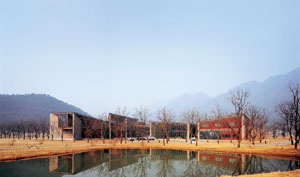by Daniel Fox
Event: 3×3 A Perspective On China, Monthly Lecture Series: Part Eight — Conversation With Yung Ho Chang
Location: Center for Architecture, 03.19.07
Speaker: Yung Ho Chang — Principal Architect, Atelier Feichang Jianzhu (FCJZ) & Professor and Head, Department of Architecture at Massachusetts Institute of Technology (MIT)
Organizer: People’s Architecture
Sponsor: Center for Architecture

An installation of habitable cameras exemplifies Atelier FCJZ’s interest in creating framed and frameless perceptions of space and landscape.
Atelier FCJZ
Yung Ho Chang has hurdled conventional boundaries of place, culture, and professional specialization. Founder and principal partner of Beijing-based Atelier Feichang Jianzhu (FCJZ), he has also directed MIT’s architecture program since 2005. His trans-Pacific design career exemplifies an interdisciplinary ambition to complement history with modernity, landscape with buildings, and most recently, architectural rumination with popular film noir.
Chang presented a series of cinematic stills of his firm’s work superimposed with scenes from the Hong Kong film trilogy, Wu Jian Zao (Infernal Affairs, 2002-03), which inspired Martin Scorcese’s The Departed. FCJZ implanted stills from the original film with new objects and characters, such as a bicycle, a Van Gogh painting, or a mysterious hand and body. Simultaneously provocative and absurd, the vignettes mingle fiction with reality. Chang said he chose Infernal Affairs over the visually lush In the Mood for Love (dir. Wong Kar Wai, 2000) because he could tell the story with only a handful of images. He also cited the French New Wave movement and Alfred Hitchcock as cinematic inspirations.
This experiment represents Chang’s latest attempt to study and catalyze the act of perception. Long interested in Chinese scroll landscape painting as well as early Renaissance painting, photography, and film, he has designed exhibitions and buildings that challenge viewers to see their environs anew. For example, a landmark series of projects emerged from an enquiry into peepshow mechanics and Alfred Hitchcock’s classic take on urban voyeurism, Rear Window. In 2003, FCJZ worked with two video artists to create a series of giant, inhabitable sculptures modeled on Leica, Nikon, Polaroid, and Seagull rangefinder cameras.
This “Camera” exhibition helped fuel the design of the dramatic Villa Shizilin, a 45,000-square-foot home located in a rolling persimmon orchard outside Beijing. Chang conceived the house as an interlocking assembly of tapered, wedge-like volumes that function as focused lenses to frame views of the landscape. Drawing the viewer’s eyes horizontally along the landscape, the villa’s distinctly long, low window stripes recall the continuous, kinetic quality of scroll landscape paintings.
The work of Yung Ho Chang and FCJZ is the subject of the current exhibition “DEVELOP” on display at the MIT Wolk Gallery in Cambridge, MA, through 04.13.07.
Gideon Fink Shapiro is a writer and researcher at Gabellini Sheppard Associates, and contributes to several design publications.

